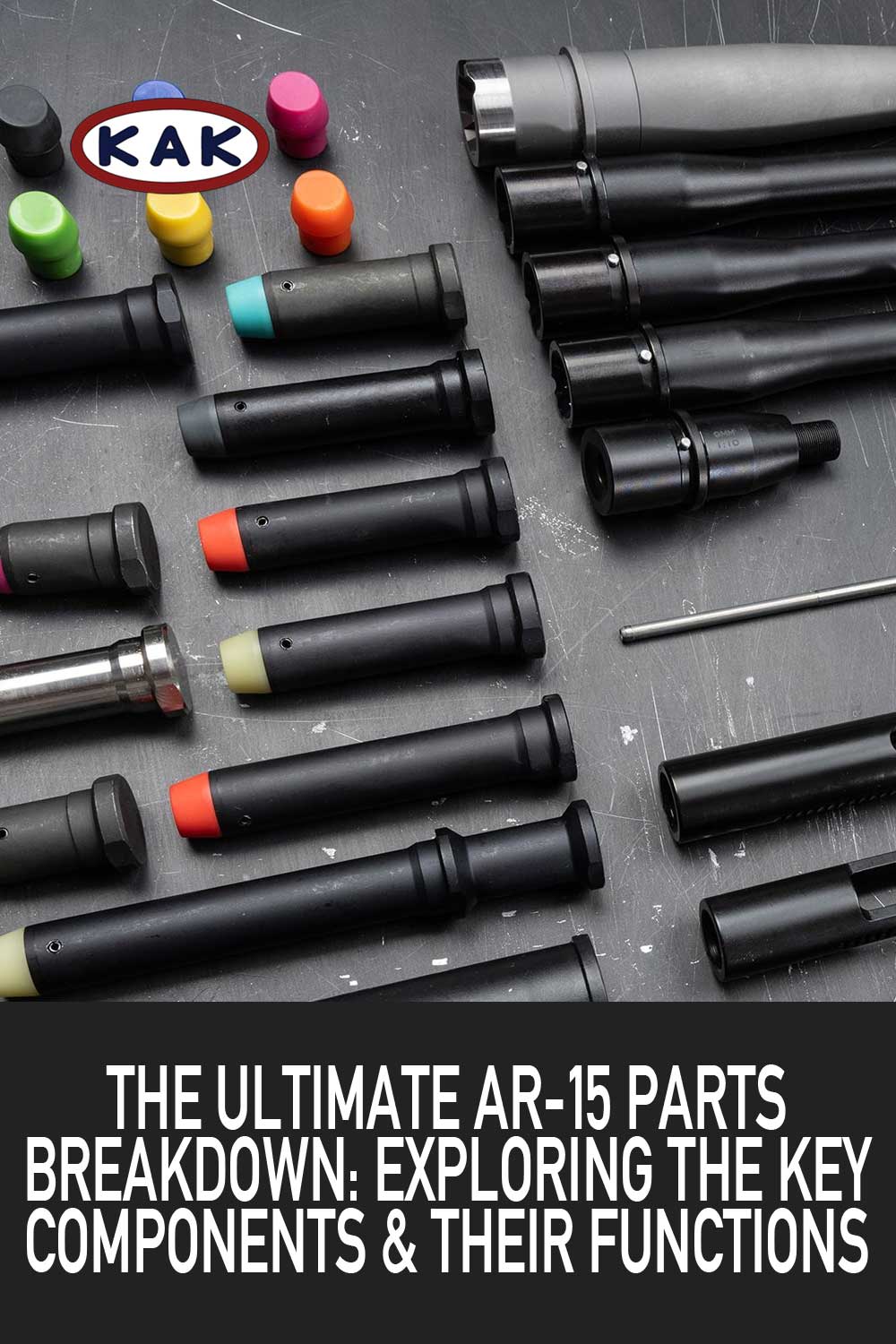Welcome to the ultimate AR-15 parts breakdown, where we discuss the key components and their functions of one of the most iconic firearms in history. Whether you’re a gun enthusiast, an avid shooter, or simply curious about the inner workings of this versatile rifle, this comprehensive guide has you covered.
From the barrel to the stock, we’ll explore each component in detail, unraveling the mysteries and highlighting their crucial roles in the AR-15’s performance. Whether it’s understanding the importance of the bolt carrier group or learning about the intricacies of the gas system, we aim to provide a clear and concise overview that leaves no stone unturned.
With our expert insights and accessible language, we’ll ensure that you understand how each part contributes to the overall functionality, accuracy, and reliability of your AR-15. Whether you’re considering upgrading specific components or simply want a deeper understanding of the weapon, this article serves as a valuable resource for both beginners and seasoned AR-15 owners.
Understanding the basic components of an AR-15
The AR-15 rifle consists of several key components, each playing a vital role in its overall functionality. Understanding these components is essential for any gun enthusiast or owner. Let’s take a closer look at each of these components and their functions.
1. Upper Receiver Group: Exploring the Key Components and Their Functions
The upper receivers, or upper parts, contains the barrel, gas system, handguard, and various other components. The barrel is responsible for guiding the bullet’s path and determining its accuracy. The gas system regulates the amount of gas used to cycle the action and eject the spent casing. The handguard provides a mounting platform for accessories and protects the shooter’s hand from the hot barrel. These components, work in harmony to ensure the rifle’s reliability and performance.
2. Lower Receiver Group: Exploring the Key Components and Their Functions
Lower receivers house the trigger group, magazine well, and stock attachment point. The trigger group is responsible for releasing the hammer and firing the rifle. The magazine well allows for the insertion and removal of magazines. The stock attachment point connects the lower receiver to the stock, providing stability and control. Together, these components, known as lower parts, facilitate the firing and handling of the AR-15.
3. Barrel and Gas System: Exploring the Key Components and Their Functions
The barrel is the heart of the AR-15, determining its accuracy and range. It consists of the chamber, rifling, and muzzle device. The chamber holds the cartridge and provides a seal for the expanding gases. The rifling imparts spin to the bullet, stabilizing its flight. The muzzle device reduces recoil and redirects muzzle flash. The gas system, comprised of the gas block, gas tube, and gas key, regulates the flow of gas to cycle the action. The gas system components and ar-15 barrels, work together to ensure the rifle’s accuracy and reliability.
4. Bolt Carrier Group: Exploring the Key Components and Their Functions
The bolt carrier group is a critical component responsible for chambering, extracting, and ejecting cartridges. It consists of the bolt, carrier, gas rings, and firing pin. The bolt is responsible for locking and unlocking the chamber. The carrier houses the bolt and reciprocates within the upper receiver. The gas rings provide a seal to prevent gas leakage. The firing pin strikes the primer, igniting the propellant. Understanding the bolt carrier group is essential for maintaining and troubleshooting the AR-15.
5. Handguard and Rail System: Exploring the Key Components and Their Functions
The handguard and rail system provide a mounting platform for accessories, such as optics, lights, and grips. They also protect the shooter’s hand from the hot barrel during rapid fire. The handguard can be either free-floating or drop-in, depending on the shooter’s preference. The rail system, typically Picatinny or M-Lok, allows for modular attachment of accessories. These components enhance the versatility and customization options of the AR-15.
6. Stock and Buffer System: Exploring the Key Components and Their Functions
The AR-15 stock and buffer system provide stability and control while shooting the AR-15. The stock attaches to the lower receiver and allows for adjustment of length of pull. It also houses the buffer tube, buffer spring, and buffer. The buffer system absorbs recoil and helps cycle the action smoothly. Choosing the right stock and buffer system is crucial for comfort and shooting performance.
7. Trigger Group: Exploring the Key Components and Their Functions
The trigger group consists of the trigger, hammer, and disconnector. It is responsible for releasing the hammer and firing the rifle. The trigger pull weight, reset, and overall feel can greatly impact the shooter’s accuracy and control. Understanding the intricacies of the trigger group can help enhance the shooting experience and improve performance.
Handguard and rail system: Exploring the key components and their functions
The handguard and rail system of the AR-15 provide a platform for accessory attachment and protection for the shooter’s hands. Let’s explore the key components and their functions within this system.
1. Handguard
The handguard is the component that surrounds the barrel, providing a protective covering and allowing for a comfortable grip. It protects the shooter’s hands from the heat generated during rapid fire and allows for better control of the rifle. AR-15 handguards can be made from various materials, such as polymer or aluminum, and they come in different lengths and styles to accommodate different shooting preferences.
2. Picatinny Rail
The Picatinny rail, also known as a MIL-STD-1913 rail, is a standardized system for mounting accessories to the AR-15. It features a series of closely spaced slots that allow for the attachment of various accessories, such as optics, lights, lasers, and grips. The rail system provides versatility and customization options, allowing shooters to personalize their AR-15 based on their specific needs and shooting style.
3. M-Lok and KeyMod
M-Lok and KeyMod are alternative attachment systems to the Picatinny rail, offering a lighter and more streamlined approach to mounting accessories. M-Lok features a series of slots that allow for direct attachment of accessories, while KeyMod utilizes keyholes for accessory attachment. Both systems provide a slimmer profile and reduce the overall weight of the rifle, while still offering compatibility with a wide range of accessories.
Maintenance and upgrades for your AR-15 rifle
Maintaining and upgrading your AR-15 is essential for optimal performance and longevity. Let’s explore some key tips and considerations for keeping your rifle in top shape.
1. Cleaning and Lubrication
Regular cleaning and lubrication are crucial for keeping your AR-15 functioning smoothly. Cleaning the barrel, bolt carrier group, and other critical components removes fouling and debris, ensuring reliable operation. Proper lubrication reduces friction and wear, enhancing the overall lifespan of your rifle.
2. Parts Replacement
Over time, certain components of your AR-15 may wear out or become damaged. It is important to regularly inspect and replace worn or damaged parts to maintain the rifle’s performance and safety. Key components to consider replacing include springs, extractors, and trigger components.
3. Upgrades
Upgrading specific components of your AR-15 can enhance its performance and tailor it to your specific needs. Consider upgrades such as match-grade barrels, enhanced triggers, adjustable gas blocks, or improved handguards. However, it is crucial to research and ensure compatibility with your specific rifle to avoid any potential issues.
In conclusion, understanding the key components and their functions within the AR-15 is essential for any enthusiast or owner. Each part plays a crucial role in the rifle’s performance, accuracy, and reliability. By exploring the upper receiver and lower receiver groups, barrel and gas system, bolt carrier group, handguard and rail system, stock and buffer system, trigger group, and maintenance and upgrades, you can gain a comprehensive understanding of this iconic firearm. Whether you’re a beginner or a seasoned AR-15 owner, this guide serves as a valuable resource for unlocking the mysteries and optimizing the performance of your AR-15 rifle.





Add comment